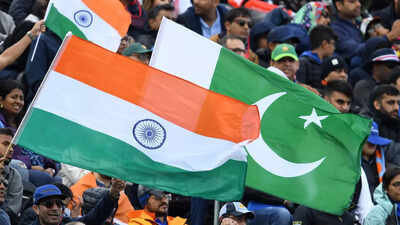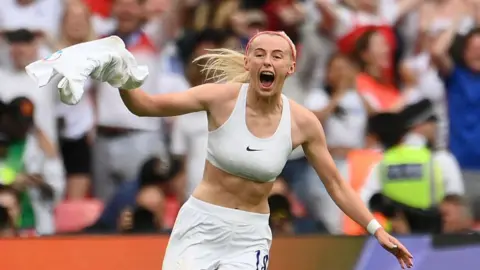 Getty Images
Getty ImagesThe Euros are reaching their conclusion in a massive summer across women’s sport.
But away from the drama and excitement on the pitch, there is also a scientific revolution taking place.
Teams of scientists are researching the unique ways that elite sport affects the female body – how breasts alter the way you run, but the right sports bra could give you the edge; how the menstrual cycle could impact performance and what role period trackers could play; and why is there a higher risk of some injuries, and what can be done to avoid them?
It’s a far cry from the era when professional female athletes told me they were thought of simply as “mini-men”.
Breast biomechanics
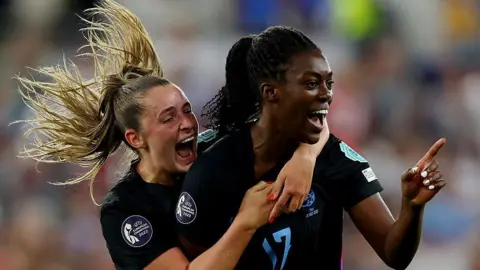 Getty Images
Getty ImagesCast your mind back to the iconic scene from the final of the last European Championships in 2022.
It was extra time at Wembley and Lioness Chloe Kelly scored the winning goal against Germany.
In the ensuing euphoria, she whipped off her England shirt showing the world her sports bra.
It was fitted by Prof Joanna Wakefield-Scurr, from the University of Portsmouth, who proudly goes by the nickname the Bra Professor.
Here are her breast facts:
- Breasts can bounce an average of 11,000 times in a football match
- An average bounce is 8cm (3in) without appropriate support
- They move with up to 5G of force (five times the force of gravity), comparable to the experience of a Formula 1 driver
Laboratory experiments – using motion sensors on the chest – have revealed how a shifting mass of breast tissue alters the movement of the rest of the body, and in turn, sporting performance.
“For some women, their breasts can be really quite heavy and if that weight moves, it can change the movement of your torso, it can even change the amount of force that you exert on the ground,” Prof Wakefield-Scurr tells me.
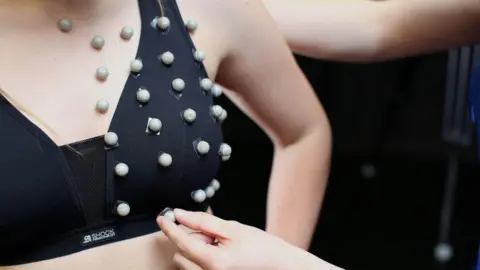 University of Portsmouth
University of PortsmouthCompensating for bouncing breasts by restricting the movement of your upper body alters the positioning of the pelvis and shortens the length of each stride. That’s why sports bras are not just for comfort or fashion, but a piece of performance gear.
“We actually saw that low breast support meant a reduction in stride length of four centimetres,” Prof Wakefield-Scurr explains.
“If you lost four centimetres every step in a marathon, it adds up to a mile.”
Sports bras also protect the delicate structures inside the breast, “if we stretch them, that’s permanent,” the professor says, so “it’s about prevention rather than cure”.
The menstrual cycle and its effect on performance
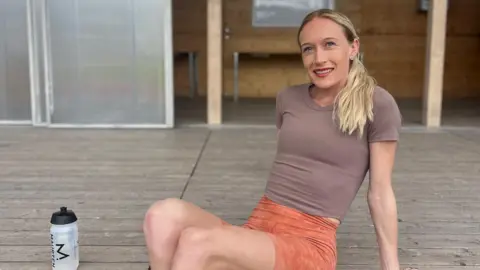 Calli Hauger-Thackery
Calli Hauger-ThackeryThe menstrual cycle has a clear impact on the body – it can affect emotions, mood and sleep as well as cause fatigue, headache and cramps.
But Calli Hauger-Thackery, a distance runner who has represented Team GB at the Olympics, says talking about its sporting impact is “still so taboo and it shouldn’t be, because we’re struggling with it”.
Calli says she always notices the difference in her body in the lead up to her period.
“I’m feeling really fatigued, heavy legs, I [feel like I’m] almost running through mud sometimes, everything’s more strained than it should be,” she says.
Calli finds she “lives” by her menstruation tracker, as being on her period is a source of anxiety “especially when I’ve got big races coming up”.
One of those big races was in April – the Boston Marathon – and Calli’s period was due. She finished in sixth place, and recalls that she “luckily got through” – but says she can’t help wondering if she could have done even better.
The menstrual cycle is orchestrated by the rhythmic fluctuations of two hormones – oestrogen and progesterone. But how big an impact can that have on athletic performance?
“It’s very individual and there’s a lot of nuance here, it’s not quite as simple as saying the menstrual cycle affects performance,” says Prof Kirsty Elliott-Sale, who specialises in female endocrinology and exercise physiology at Manchester Metropolitan University.
“Competitions, personal bests, world records, everything has been set, won and lost on every day of the menstrual cycle,” she says.
This famously includes Paula Radcliffe, who broke the marathon world record while running through period cramps in Chicago in 2002.

Working out whether the menstrual cycle affects sporting ability requires an understanding of the physiological changes that hormones have throughout the body, the challenge of performing while experiencing symptoms, the psychological impact of the anxiety of competing during your period and perceptions about all of the above.
Prof Elliott-Sale says there “isn’t a phase where you’re stronger or weaker”, or where “you’re going to win or you’re going to lose”, but in theory the hormones oestrogen and progesterone could alter parts of the body such as bone, muscle or heart.
“What we don’t yet understand is: Does that have a big enough effect to really impact performance?” she says.
The professor adds that it is “a very sensible conclusion” that poor sleep, fatigue and cramping would have a knock-on effect on performance, and that dread and anxiety were an “absolutely tangible thing” for athletes on their period who are performing in front of large crowds.
She has spoken to athletes who “sometimes even triple up with period pants” to avoid the risk of leaking and embarrassment, and “that’s a heavy mental burden”.
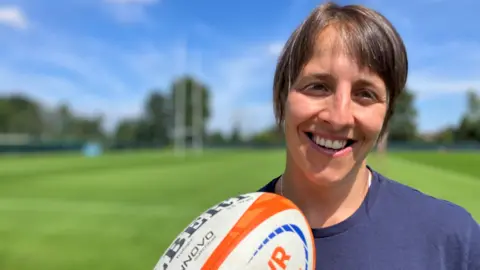
Rugby union team, Sale Sharks Women have been working with Manchester Metropolitan University.
I met Katy Daley-McLean, former England rugby captain and England all-time leading point scorer.
The team are having open discussions around periods to help them understand the impact that menstruation can have, and how to plan for it. This includes taking ibuprofen three days before, rather than thinking: “I can’t do anything about it,” Daley-McLean says.
“It’s through that knowledge and that information that we can talk about this, we can put plans in place, and we can change our behaviour to make you a better rugby player,” she says.
How to avoid injuries
One issue that has emerged as women’s sport has been given more attention is a difference in the susceptibility to some injuries.
Most of the attention has been around the anterior cruciate ligament (ACL) – a part of the knee that attaches the upper and lower parts of the leg together. Injuries can be brutal and take a year to recover from.
Not only is the risk three to eight times greater in women than men, depending on the sport, but they are becoming more common, says Dr Thomas Dos’Santos, a sports biomechanics researcher at Manchester Metropolitan University.
However, there is “no simple answer” to explain the greater risk in women, he says.
Partly it could be down to differences in anatomy. Bigger hips in women mean the top of the thigh bone starts from a wider position and this changes the angle it connects to the lower leg at the knee, potentially increasing risk.
The ACL is also slightly smaller in women “so it’s a little bit weaker, potentially”, Dr Dos’Santos explains.

ACL injuries can happen at all stages of the menstrual cycle, but hormonal changes are also being investigated, including a study sponsored by Fifa, the governing body for world football.
High levels of oestrogen prior to ovulation could alter the properties of ligaments, making them a bit more stretchy so “there could be an increased risk of injury, theoretically,” he says.
But Dr Dos’Santos argues it’s important to think beyond pure anatomy as women still do not get the same quality of support and strength training as men.
He compares it to ballet, where dancers do receive good quality training. “The [difference in] incidence rates is basically trivial between men and women,” Dr Dos’Santos says.
There is research into whether it is possible to minimise the risk of ACL injuries, by training female athletes to move in subtly different ways.
But there is a risk of lessening performance, and some techniques that put strain on the ACL – like dropping the shoulder to deceive a defender before bursting off in another direction – are the necessary moves in sports like football.
“We can’t wrap them up in cotton wool and say you should avoid playing sport,” Dr Dos’Santos says. “What we need to do is make sure that they’re strong enough to tolerate those loads, but it isn’t just as simple as some people saying we can 100% eradicate ACL injuries, we can’t.”
No longer ‘mini-men’
Even though there are still many unanswered question, it is still a world of difference for Katy Daley-McLean at Sale Sharks Women.
When she got her first cap in 2007, she remembers that all the assumptions around how her body would perform were based on the data from male rugby players.
“We were literally treated as mini-men,” Daley-McLean recalls.
And now, she says, girls and women don’t feel like the outsiders in sport, which is not only improving performance at the elite level but helping to keep more women in sport.
“It’s awesome, it’s something to be celebrated because if you look at the stats, one of the biggest reasons young girls drop out of sport is body image, it’s around periods and not having a correct sports bra, which is so easily sorted.”
Inside Health was produced by Gerry Holt


